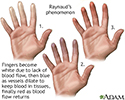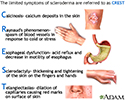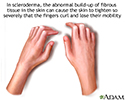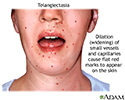Scleroderma
Progressive systemic sclerosis; Systemic sclerosis; Limited scleroderma; CREST syndrome; Localized scleroderma; Morphea - linear; Raynaud's phenomenon - scleroderma
Scleroderma is a disease that involves the buildup of scar-like tissue in the skin and elsewhere in the body. It also damages the cells that line the walls of the small arteries.
Causes
Scleroderma is a type of autoimmune disorder . In this condition, the immune system mistakenly attacks and damages healthy body tissue.
Autoimmune disorder
An autoimmune disorder occurs when the body's immune system attacks and destroys healthy body tissue by mistake. There are more than 80 types of aut...

The cause of scleroderma is unknown. A buildup of a substance called collagen in the skin and other organs leads to the symptoms of the disease.
The disease most often affects people 30 to 50 years old. Women get scleroderma more often than men. Some people with scleroderma have a history of being around silica dust and polyvinyl chloride, but most do not.
Widespread scleroderma can occur with other autoimmune diseases, including systemic lupus erythematosus and polymyositis . These cases are referred to as undifferentiated connective tissue disease or overlap syndrome.
Systemic lupus erythematosus
Systemic lupus erythematosus (SLE) is an autoimmune disease. In this disease, the body's immune system mistakenly attacks healthy tissue. It can af...

Polymyositis
Polymyositis is a rare inflammatory disease. It leads to muscle weakness, swelling tenderness, and tissue damage. It is part of a larger group of d...

Symptoms
Some types of scleroderma affect only the skin, while others affect the whole body.
- Localized scleroderma: Often affects only the skin on the hands and face. It develops slowly, and rarely spreads in the body or causes serious problems.
- Systemic scleroderma, or sclerosis: May affect large areas of skin and organs such as the heart, lungs, or kidneys. There are two main types: limited disease (CREST syndrome) and diffuse disease.
Skin symptoms of scleroderma may include:
-
Fingers or toes that turn blue or white in response to cold temperatures (
Raynaud phenomenon
)
Raynaud phenomenon
Raynaud phenomenon is a condition in which cold temperatures or strong emotions cause blood vessel spasms. This blocks blood flow to the fingers, to...
 ImageRead Article Now Book Mark Article
ImageRead Article Now Book Mark Article - Stiffness and tightness of skin of fingers, hands, forearm, and face
- Hair loss
- Skin that is darker or lighter than normal
- Small white lumps beneath the skin that sometimes ooze a white substance that looks like toothpaste
- Sores (ulcers) on the fingertips or toes
- Tight and mask-like skin on the face
Bone and muscle symptoms may include:
- Joint pain
- Numbness and pain in the feet
- Pain, stiffness, and swelling of fingers and joints
- Wrist pain
Breathing problems may result from scarring in the lungs and can include:
- Dry cough
- Shortness of breath
-
Wheezing
Wheezing
Wheezing is a high-pitched whistling sound during breathing. It occurs when air moves through narrowed breathing tubes in the lungs.
 ImageRead Article Now Book Mark Article
ImageRead Article Now Book Mark Article
Digestive tract problems may include:
- Difficulty swallowing
-
Esophageal reflux
or
heartburn
Esophageal reflux
Gastroesophageal reflux disease (GERD) is a condition in which the stomach contents leak backwards from the stomach into the esophagus (the tube from...
 ImageRead Article Now Book Mark Article
ImageRead Article Now Book Mark ArticleHeartburn
Heartburn is a painful burning feeling just below or behind the breastbone. Most of the time it comes from the esophagus. The pain often rises in y...
 ImageRead Article Now Book Mark Article
ImageRead Article Now Book Mark Article - Bloating after meals
- Constipation
- Diarrhea
- Problems controlling stools
Exams and Tests
The health care provider will do a complete physical exam. The exam may show:
- Tight, thick skin on the fingers, the face or elsewhere.
- The skin at the edge of the fingernails may be looked at with a lighted magnifying glass for abnormalities of the small blood vessels.
- The lungs, heart and abdomen will be examined for abnormalities.
Your blood pressure will be checked. Scleroderma can cause small blood vessels in the kidneys to become narrowed. Problems with your kidneys can lead to high blood pressure and decrease function of the kidney.
Blood and urine tests may include:
-
Antinuclear antibody
(ANA) panel
Antinuclear antibody
The antinuclear antibody panel is a blood test that looks at antinuclear antibodies (ANA). ANA are substances produced by the immune system that atta...
 ImageRead Article Now Book Mark Article
ImageRead Article Now Book Mark Article - Scleroderma antibody testing
-
ESR
(sed rate)
ESR
ESR stands for erythrocyte sedimentation rate. It is commonly called a "sed rate. "It is a test that indirectly measures how much inflammation is in...
Read Article Now Book Mark Article -
Rheumatoid factor
Rheumatoid factor
Rheumatoid factor (RF) is a blood test that measures the amount of the RF antibody in the blood.
 ImageRead Article Now Book Mark Article
ImageRead Article Now Book Mark Article - Complete blood count
- Metabolic panel, including creatinine
- Heart muscle tests
-
Urinalysis
Urinalysis
Urinalysis is the physical, chemical, and microscopic examination of urine. It involves a number of tests to detect and measure various compounds th...
 ImageRead Article Now Book Mark Article
ImageRead Article Now Book Mark Article
Other tests may include:
-
Chest x-ray
Chest x-ray
A chest x-ray is an x-ray of the chest, lungs, heart, large arteries, ribs, and diaphragm.
 ImageRead Article Now Book Mark Article
ImageRead Article Now Book Mark Article -
CT scan of the lungs
CT scan of the lungs
A chest CT (computed tomography) scan is an imaging method that uses x-rays to create cross-sectional pictures of the chest and upper abdomen....
 ImageRead Article Now Book Mark Article
ImageRead Article Now Book Mark Article - Electrocardiogram (ECG)
-
Echocardiogram
Echocardiogram
An echocardiogram is a test that uses sound waves to create pictures of the heart. The picture and information it produces is more detailed than a s...
 ImageRead Article Now Book Mark Article
ImageRead Article Now Book Mark Article - Tests to see how well your lungs and gastrointestinal (GI) tract are working
-
Skin biopsy
Skin biopsy
A skin lesion biopsy is when a small amount of skin is removed so it can be examined. The skin is tested to look for skin conditions or diseases. A...
 ImageRead Article Now Book Mark Article
ImageRead Article Now Book Mark Article
Treatment
There is one no specific treatment for scleroderma. Your provider will assess the extent of disease in the lungs, kidneys, heart, and gastrointestinal tract.
You will be prescribed medicines and other treatments to control your symptoms and prevent complications.
Medicines used to treat scleroderma include:
- Corticosteroids such as prednisone: Doses above 10 mg per day are not recommended.
- Drugs that suppress the immune system such as methotrexate or mycophenolate.
- Nonsteroidal anti-inflammatory drugs (NSAIDs) for short periods.
- Hydroxychloroquine to treat arthritis.
Other treatments for specific symptoms may include:
- Treatments to improve Raynaud phenomenon: These include medicines, gloves to keep the hands warm, and not smoking.
- Medicines for heartburn or swallowing problems, such as omeprazole.
- Blood pressure medicines, such as ACE inhibitors, for high blood pressure or kidney problems.
- Light therapy to relieve skin thickening.
- Medicines to improve lung function, such as bosentan and sildenafil.
Treatment often involves physical therapy as well.
Support Groups
Some people can benefit from attending a support group for people with scleroderma.
Support group
The following organizations are good resources for information on scleroderma:American College of Rheumatology -- www. rheumatology. org/practice/cli...

Outlook (Prognosis)
In some people, symptoms develop quickly for the first few years and continue to get worse. However, in most people, the disease gets worse slowly.
People who have only skin symptoms have a better outlook. Widespread (systemic) scleroderma can lead to.
- Heart failure
- Scarring of the lungs, called pulmonary fibrosis
- High blood pressure in the lungs (pulmonary hypertension)
- Kidney failure
- Problems absorbing nutrients from food
- Cancer
When to Contact a Medical Professional
Call your health care provider if your symptoms become worse or new symptoms develop.
References
Mendoza FA, Nagle SJ, Lee JB, Jimenez SA. A prospective observational study of mycophenolate mofetil treatment in progressive diffuse cutaneous systemic sclerosis of recent onset. J Rheumatol . 2012;39:1241. PMID: 22467932 www.ncbi.nlm.nih.gov/pubmed/22467932 .
Walker KM, Pope J; participating members of the Scleroderma Clinical Trials Consortium (SCTC); Canadian Scleroderma Research Group (CSRG). Treatment of systemic sclerosis complications: what to use when first-line treatment fails--a consensus of systemic sclerosis experts. Semin Arthritis Rheum . 2012;42(1):42-55
Varga J. Etiology and pathogenesis of scleroderma. In: Firestein GS, Budd RC, Gabriel SE, et al, eds. Kelley's Textbook of Rheumatology . 9th ed. Philadelphia, PA: Elsevier Saunders; 2012:chap 83.
Varga J. Systemic sclerosis (scleroderma). In: Goldman L, Schafer AI, eds. Goldman's Cecil Medicine . 25th ed. Philadelphia, PA: Elsevier Saunders; 2016:chap 267.
-
Raynaud's phenomenon - illustration
Raynaud's phenomenon is characterized by fingers becoming white due to lack of blood flow, then blue due to oxygen consumption, and finally red as blood flow returns.
Raynaud's phenomenon
illustration
-
CREST syndrome - illustration
The symptoms involved in CREST syndrome are associated with the generalized form of the disease Systemic sclerosis (scleroderma). CREST is an acronym for the clinical features that are seen in a patient with this disease. The “C” stands for calcinosis, where calcium deposits form under the skin on the fingers or other areas of the body. The “R”, stands for Raynaud’s phenomenon, spasm of blood vessels in the fingers or toes in response to cold or stress. The “E” represents esophageal dysmotility, which can cause difficulty in swallowing. The “S” is for sclerodactyly, tightening of the skin causing the fingers to bend. Finally, the letter “T” is for telangiectasia, dilated vessels on the skin of the fingers, face, or inside of the mouth. Usually only 2 of the 5 symptoms of the CREST syndrome is necessary to be diagnosed with the disease.
CREST syndrome
illustration
-
Sclerodactyly - illustration
The most classic symptom of scleroderma is a type of skin tightening called sclerodactyly. The initial stages of the disease involves swelling of the fingers. Later, as the connective tissue becomes fibrotic, skin on the fingers and toes becomes hard and shiny. The fingers can become difficult to bend and can form contractures due to the severe tightening of the skin.
Sclerodactyly
illustration
-
Telangiectasia - illustration
Telangiectasia is the dilation of small superficial vessels and capillaries that cause numerous flat red marks on the hands, face and tongue. Telangiectasia can be a symptom of scleroderma or other systemic diseases.
Telangiectasia
illustration
-
Raynaud's phenomenon - illustration
Raynaud's phenomenon is characterized by fingers becoming white due to lack of blood flow, then blue due to oxygen consumption, and finally red as blood flow returns.
Raynaud's phenomenon
illustration
-
CREST syndrome - illustration
The symptoms involved in CREST syndrome are associated with the generalized form of the disease Systemic sclerosis (scleroderma). CREST is an acronym for the clinical features that are seen in a patient with this disease. The “C” stands for calcinosis, where calcium deposits form under the skin on the fingers or other areas of the body. The “R”, stands for Raynaud’s phenomenon, spasm of blood vessels in the fingers or toes in response to cold or stress. The “E” represents esophageal dysmotility, which can cause difficulty in swallowing. The “S” is for sclerodactyly, tightening of the skin causing the fingers to bend. Finally, the letter “T” is for telangiectasia, dilated vessels on the skin of the fingers, face, or inside of the mouth. Usually only 2 of the 5 symptoms of the CREST syndrome is necessary to be diagnosed with the disease.
CREST syndrome
illustration
-
Sclerodactyly - illustration
The most classic symptom of scleroderma is a type of skin tightening called sclerodactyly. The initial stages of the disease involves swelling of the fingers. Later, as the connective tissue becomes fibrotic, skin on the fingers and toes becomes hard and shiny. The fingers can become difficult to bend and can form contractures due to the severe tightening of the skin.
Sclerodactyly
illustration
-
Telangiectasia - illustration
Telangiectasia is the dilation of small superficial vessels and capillaries that cause numerous flat red marks on the hands, face and tongue. Telangiectasia can be a symptom of scleroderma or other systemic diseases.
Telangiectasia
illustration
-
Scleroderma
(In-Depth)
-
Scleroderma
(Alt. Medicine)
Review Date: 1/16/2016
Reviewed By: Gordon A. Starkebaum, MD, Professor of Medicine, Division of Rheumatology, University of Washington School of Medicine, Seattle, WA. Also reviewed by David Zieve, MD, MHA, Isla Ogilvie, PhD, and the A.D.A.M. Editorial team.




